Live event support

Live performance events including theater, music, dance, opera, use production equipment and services such as staging, scenery, mechanicals, sound, lighting, video, special effects, transport, packaging, communications, costume and makeup to convince live audience members that there is no better place that they could be at the moment. This article provides information about many of the possible production support tools and services and how they relate to each other.
Live performance events have a long history of visual scenery, lighting, costume amplification and a shorter history of visual projection and sound amplification reinforcement. This article describes the technologies that have been used to amplify and reinforce live events. The sections of this article together explain how the tools needed to stage, amplify and reinforce live events are interconnected.
Visual support
Live event visual amplification
Introduction
Live event visual amplification is the display of live and pre-recorded images as a part of a live stage event.
Visual amplification began when films, projected onto a stage, added characters or background information to a production. 35 mm motion picture projectors became available in 1910 - but which theatre or opera company first used a movie in a stage production is not known.
In 1935, less costly 16 mm film equipment allowed many other performance groups and school theaters to use motion pictures in productions.
In 1970, closed circuit video cameras and videocassette machines became available and Live Event Visual Amplification came of age. For the first time live closeups of stage performers could be displayed in real time. These systems also made it possible to show pre-recorded videos that added information & visual intensity to a live event.
One of the first video touring systems was created by video designer TJ McHose in 1975 for the rock band The Tubes using black and white television monitors.


In 1978, TJ McHose designed a touring color video system that enlarged performers at the Kool Jazz Festivals in sports stadiums across the United States.
Timeline
- 1910: 35 mm film projector
- 1935: 16 mm Kodachrome film projectors
- 1965: Sony Portapak 1/2" video tape system released
- 1967: Joshua Light Show
- 1967: Film Projector -motion picture effects
- Joffrey Ballet -Astarte
- 1968: Ant Farm Founded in San Francisco
- 1969: "TV Bra for Living Sculpture" Nam June Paik - Charlotte Moorman (2 TVs B&W)
- 1969: Video Free America Founded in San Francisco by Art Ginsberg & Skip Sweeney
- 1970: VFA -"The Continuing Story of Carol & Ferd" B&W Reality TV show display performance
- (1/2" video tapes switched live to 12 TVs B&W) Skip Sweeney Video Performer
- 1971: VFA -"All the Video You can Eat" display performance 12 TV monitor 4 input
- (1/2" video tapes switched live to 12 TVs B&W) Skip Sweeney Video Performer
- 1970: VFA -"The Continuing Story of Carol & Ferd" B&W Reality TV show display performance
- 1971: The Kitchen Founded in New York city by video artists Steina and Woody Vasulka
- 1975: "Media Burn" Ant Farm (Car crashes through wall of TVs)
- 1975: The Tubes - Live concert 6/1/75 Winterland San Francisco
- (2 B&W TV 1 cam 1/2 " video tape) T.J. McHose Video artist
- 1975: The Tubes - Boarding House SF (1 TV B&W) "Leroy's Wedding"
- video recording of priest marries couple during stage show T.J. McHose Video artist
- 1975: The Tubes - Bimbo's (4 TV B&W) T.J. McHose Video artist
- 1975: Kool Jazz Festival -music concerts in sports stadiums
- successfully attracts young African-American male audiences
- 1976: Tubes Talent Hunt Boarding House San Francisco
- 1978: Kool Jazz Festival video reinforcement at sports stadiuontent and use LED
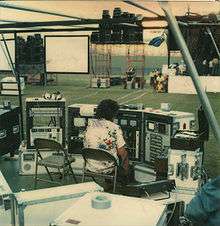 Video control center Kool Jazz Festival 1978
Video control center Kool Jazz Festival 1978- Orbec color video touring display system T.J. McHose Video designer
- (3 live TV cameras on 4 CRT TV projectors Color) Mick Anger director
- 1980: Record Factory In store video display (TJ McHose)
- 1981: MTV begins cable broadcasting
- 1982: The Who Farewell Tour Eidophor Video Projector on 22' x 30' screen
- Nocturne Productions Video Truck - Paul Becher Director
- Nocturne builds the first 2 "Broadcast" quality portable touring systems with Hitachi cameras (SK-91), Grass Valley 1600 switchers, and the GE "Talaria" projector, an idiosyncratic device which requires a board operator with a wizard's license to keep it running.
- Nocturne Productions Video Truck - Paul Becher Director
- 1982: Nocturne systems go on the road with Journey (Becher Dir.) and The Police, (Mick Anger Dir.) using a single screen over the stage center.
- 1983: David Bowie (Mick Anger Dir.) uses Nocturne video for the stadium dates on his "Serious Moonlight" tour.
- This tour was the first time a "Diamond Vision" type (LED) screen is used on a scaffold behind and above the stage for some shows, and eidophor elsewhere.
- 1984: Tasco builds a video system and begins to compete for the touring business with Nocturne
- A TimeLine of Film and Video inventions is available at howOLDisit.com
By 2000 many bands tour with LED as well as DLP projection and LED video walls
Live event visual reinforcement
Introduction
Live event visual reinforcement is the addition of projected lighting effects and images onto any type of performance venue.
Visual Reinforcement began more than 2000 years ago. In China during the Han Dynasty, Shadow puppetry was invented to "bring back to life" Emperor Wu's favorite concubine. Mongolian troops spread Shadow play throughout Asia and the Middle East in the 13th century. Shadow puppetry reached Taiwan in 1650, and missionaries brought it to France in 1767.
The next major advance in Visual reinforcement for events was the magic lantern, first conceptualized by Giovanni Battista della Porta in his 1558 work Magiae naturalis. The Magic Lantern became practical by 1750 with the oil lamp and glass lenses. Special effect animation attachments were added in the 1830s. In 1854, the Ambrotype positive photographic process on glass made Magic lantern slide creation much less expensive.
Magic lanterns were greatly improved by the application of limelight to live stage production in 1837 at Covent Garden Theatre and improved again when electric arc lighting became available in 1880.
In 1910, Adolf Linnebach invented the Linnebach lantern, a lensless wide angle glass slide projector.
In 1933, the Gobo metal shadow pattern for the ellipsoidal spotlight allowed images to appear and disappear by dimmer control.
In 1935, 16 mm Kodachrome film projectors added the first fully animated visual reinforcement to live events.
Timeline
- 1600: Shadow play leather or paper puppets cast shadows on a translucent screen
- 1760: magic lantern painted slide projector Phantasmagoria ghost effects projector
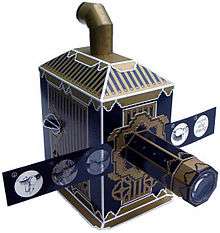 Magic Lantern image projector
Magic Lantern image projector - 1905: Linnebach lantern [1] Munich Opera
- 1933: Gobo metal shadow mask adds patterns to ellipsoidal spotlights
- 1940: Overhead projector Later used for psychedelic light shows
- 1950: Slide projector 35 mm Kodak Carousel
- 1965: Thomas Wilfred describes [2] A highly detailed system to create event scenery using rear projections
- 1967: Liquid Projector psychedelic Liquid light shows
- Joshua Light Shows at The Fillmore for The Grateful Dead, Big Brother and the Holding Company and many other Summer of Love bands
Audio support
Live event sound reinforcement
Introduction
A sound reinforcement system is professional audio, was first developed for movie theatres in 1927 when the first ever talking picture was released, called The Jazz Singer. Movie theatre sound was greatly improved in 1937 when the Shearer Horn system debuted. One of the first large-scale outdoor public address systems was at 1939 New York World's Fair.
In the 1960s, rock and roll concerts promoted by Bill Graham at The Fillmore created a need for quickly changeable sound systems. In the early 1970s, Graham founded FM Productions to provide touring sound and light systems. By 1976 in San Francisco, the technical debate over infinite baffle vs horn-loaded enclosures, and line arrays vs distributed driver arrays, was ongoing at FM because of the proximity of The Grateful Dead and their scene Ultrasound, John Meyer, and others). But at that time there were parallel developments in other parts of the United States - Showco (Dallas) and Clair Bros (Philadelphia) had different approaches; Clair in particular was moving in the direction of modular full-range enclosures. They would rig as many as needed (or clients like Bruce Springsteen could afford) in whatever configuration they thought would cover a particular venue. Stanal Sound in southern California used fiberglass futuristic looking equipment for artists like Kenny Rogers.
A number of long-time sound professionals feel that live concert sound quality has not greatly improved since 1978 despite all the digital, wireless, fiber optic and computer advancements that have made it much easier to tune to a specific venue and assemble and maintain a touring system.
Timeline
- 1876: Loudspeaker Alexander Graham Bell
- 1878: Carbon microphone / amplifier
- 1924: Loudspeaker - moving-coil -patent Chester W. Rice & E. Kellogg
- 1924: Loudspeaker - ribbon Walter H. Schottky
- 1930: Vacuum tube amplifier
- 1937: Loudspeaker - Shearer Horn movie theatre system
- 1939: public address outdoor system 1939 New York World's Fair
- 1945: Loudspeaker - coaxial Altec "Voice of the Theatre"
- 1953: Loudspeaker - electrostatic -patent Arthur Janszen
 Touring sound reinforcement system
Touring sound reinforcement system - 1953: Microphone - wireless
- 1965: Loudspeaker - woofer
- 1965: Loudspeaker - subwoofer
- 1970: Microphone - condenser
- 1974: Loudspeaker - Sensurround movie sound system for "Earthquake"
- 1974: Loudspeaker - Dolby Stereo 70 mm Six Track
- 1975: Loudspeaker - touring - McCune JM-3 John Meyer
- 1979: Loudspeaker - Meyer Sound Laboratories - Grateful Dead wall of sound
- 1983: Loudspeaker - THX movie sound system for Star Wars
Transportation support
Efficient and timely transportation is essential for live event productions. [3]
Touring packaging
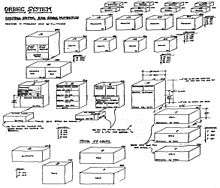
Well designed touring systemssystems unload from the truck gently, roll easily into their stage location, connect to each other quickly. A well designed system includes duplicates of critical components and "field-replaceable" items such as cables, switches and fuses. Every component should be protected by a well padded road case that has room for all connector cables and allows easy access to the components for fast cable re-patching to bypass a bad component and for repairs during a tour. The road cases need good ventilation and for outdoor use should be white to minimize solar heat buildup. Road case sizes should be modular to pack tightly together on the truck.
Packaging images
-
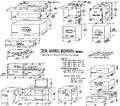
Touring cases schematic for Video display system Kool Jazz Festival 1978
-
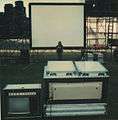
Color video projector in road case -Kool Jazz Festival
See also
- Audio electronics
- Concerts
- Concert video design
- Liquid light shows
- Live sound mixing
- Rock concert
- Rock festival
- Sound technology
- Stadiums
- Stagecraft
- Theatres
- Video designer
- VJ (video performance artist)
References
- ↑ Burris-Meyer and Cole (1938). Scenery For The Theatre.Little, Brown and company pp 246-7 Projected Scenery Effects
- ↑ Wilfred, Thomas (1965) Projected Scenery: A Technical Manual
- ↑ http://www.entertainmentcargo.com/toolbox-usefullinks.html